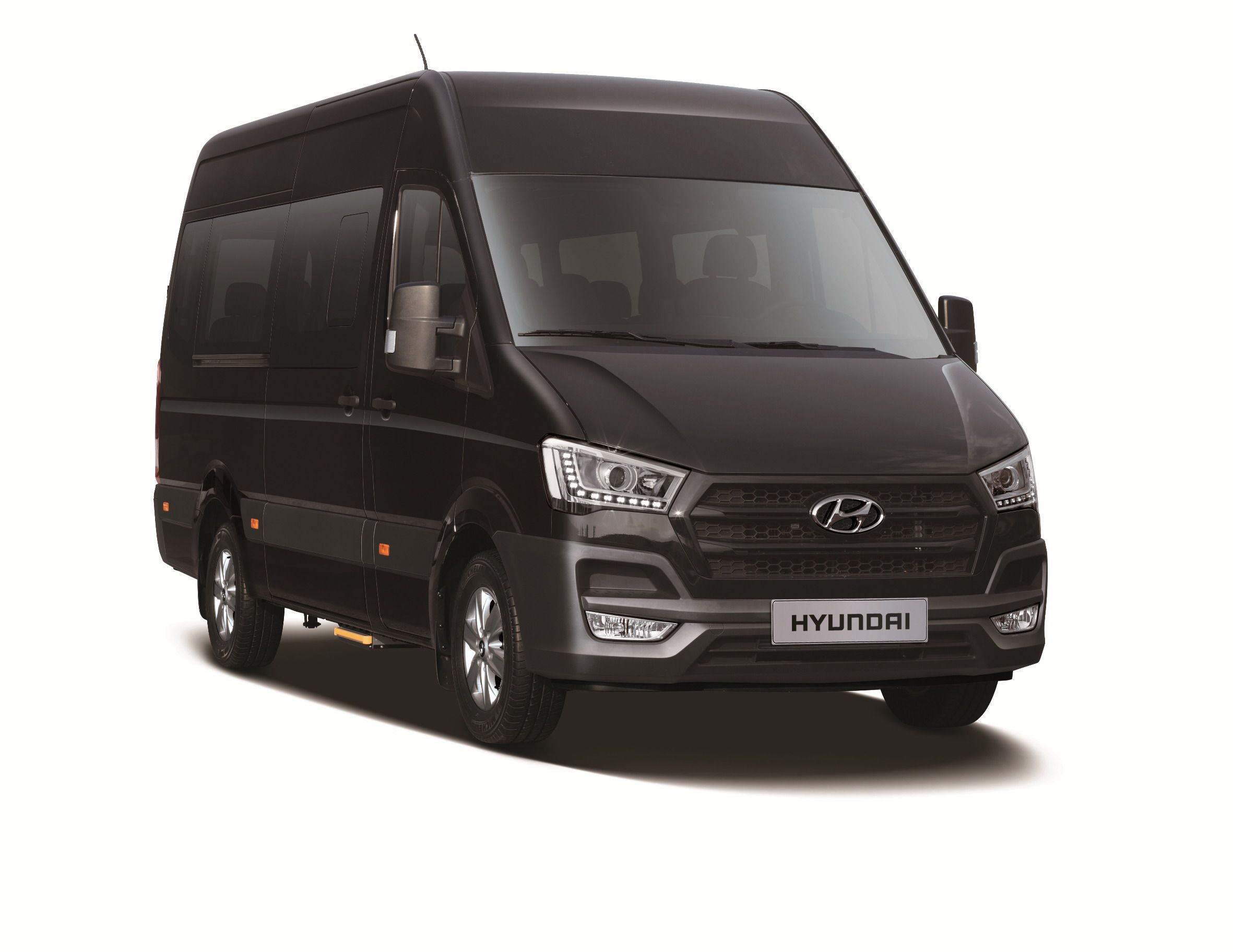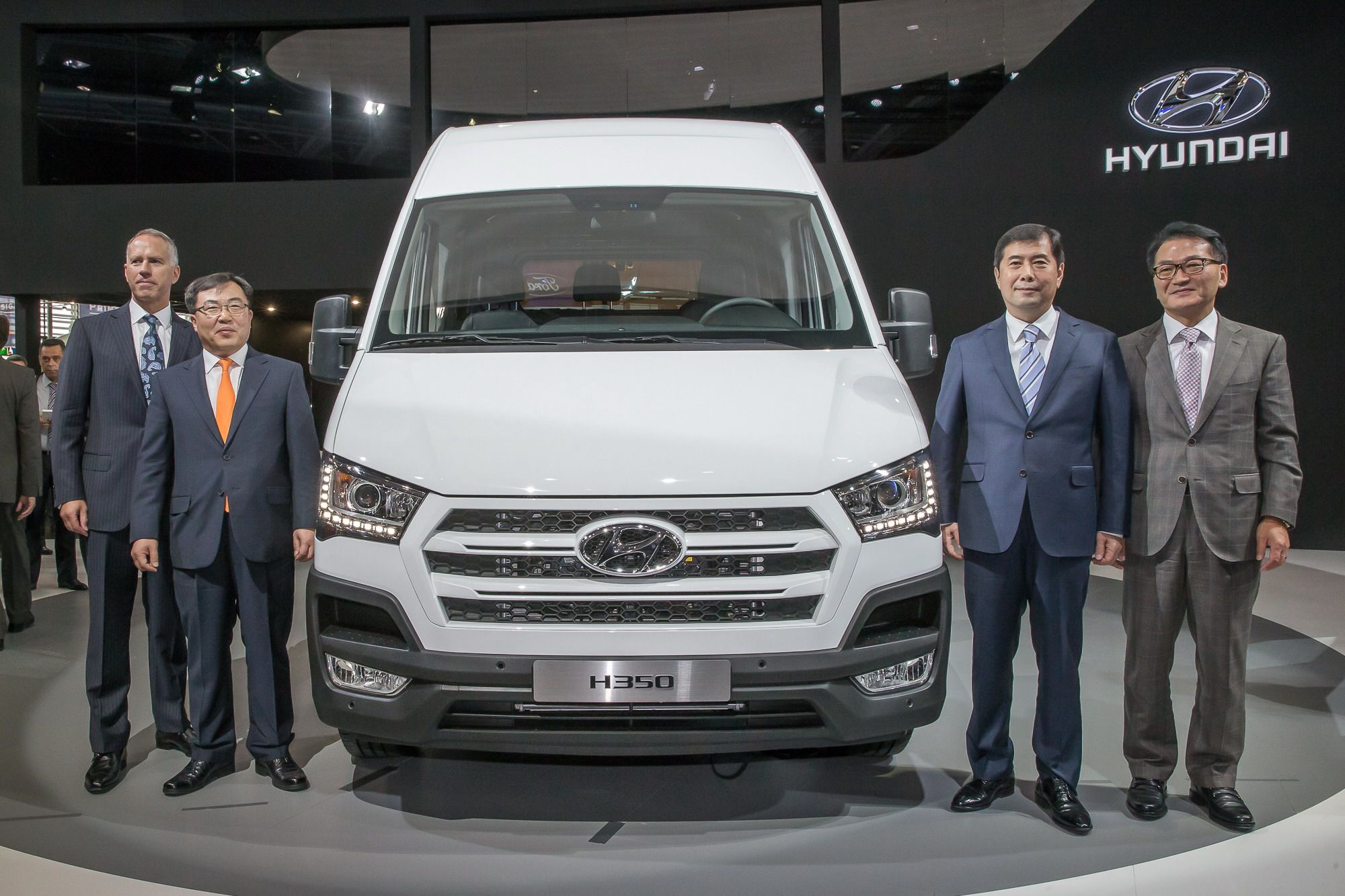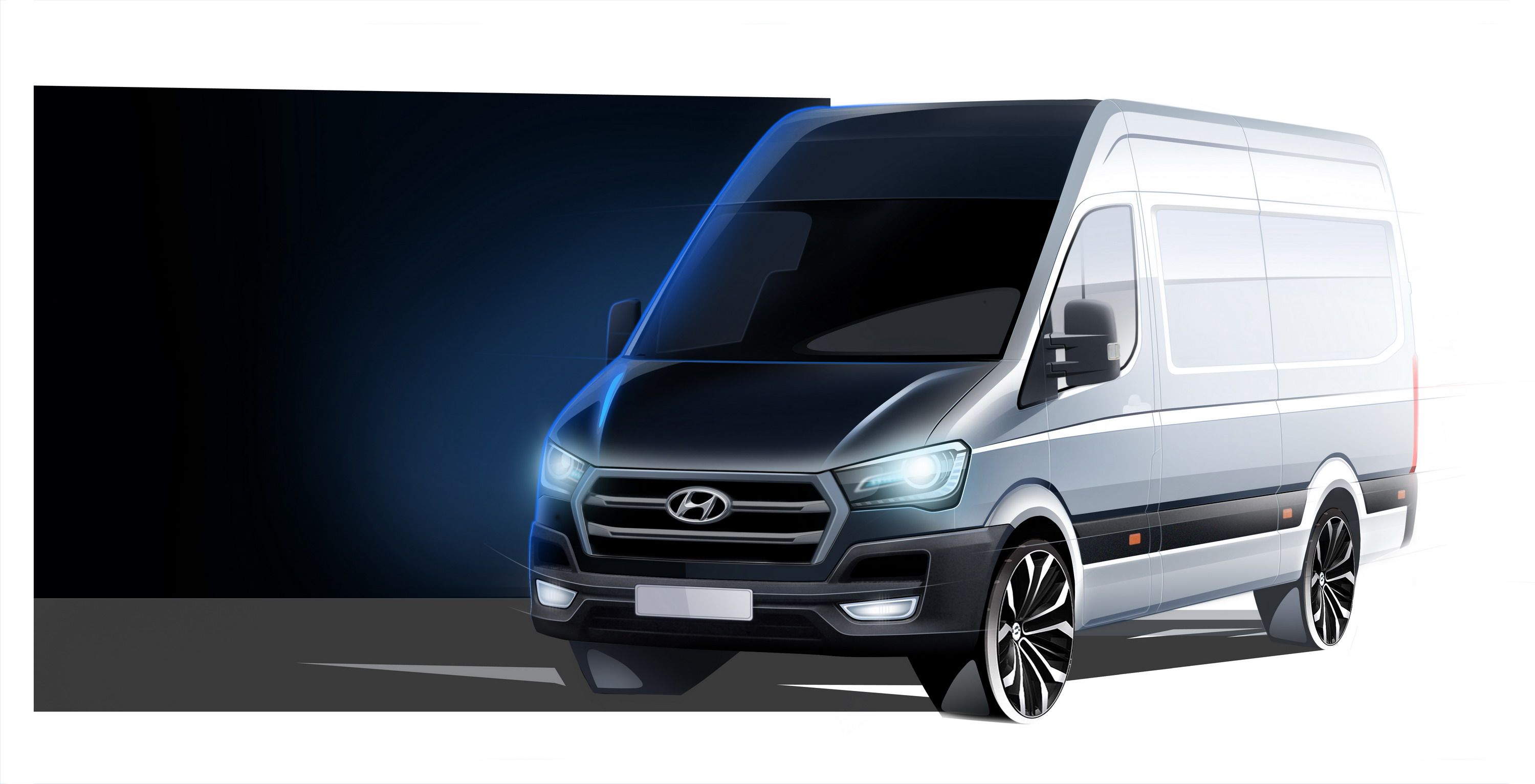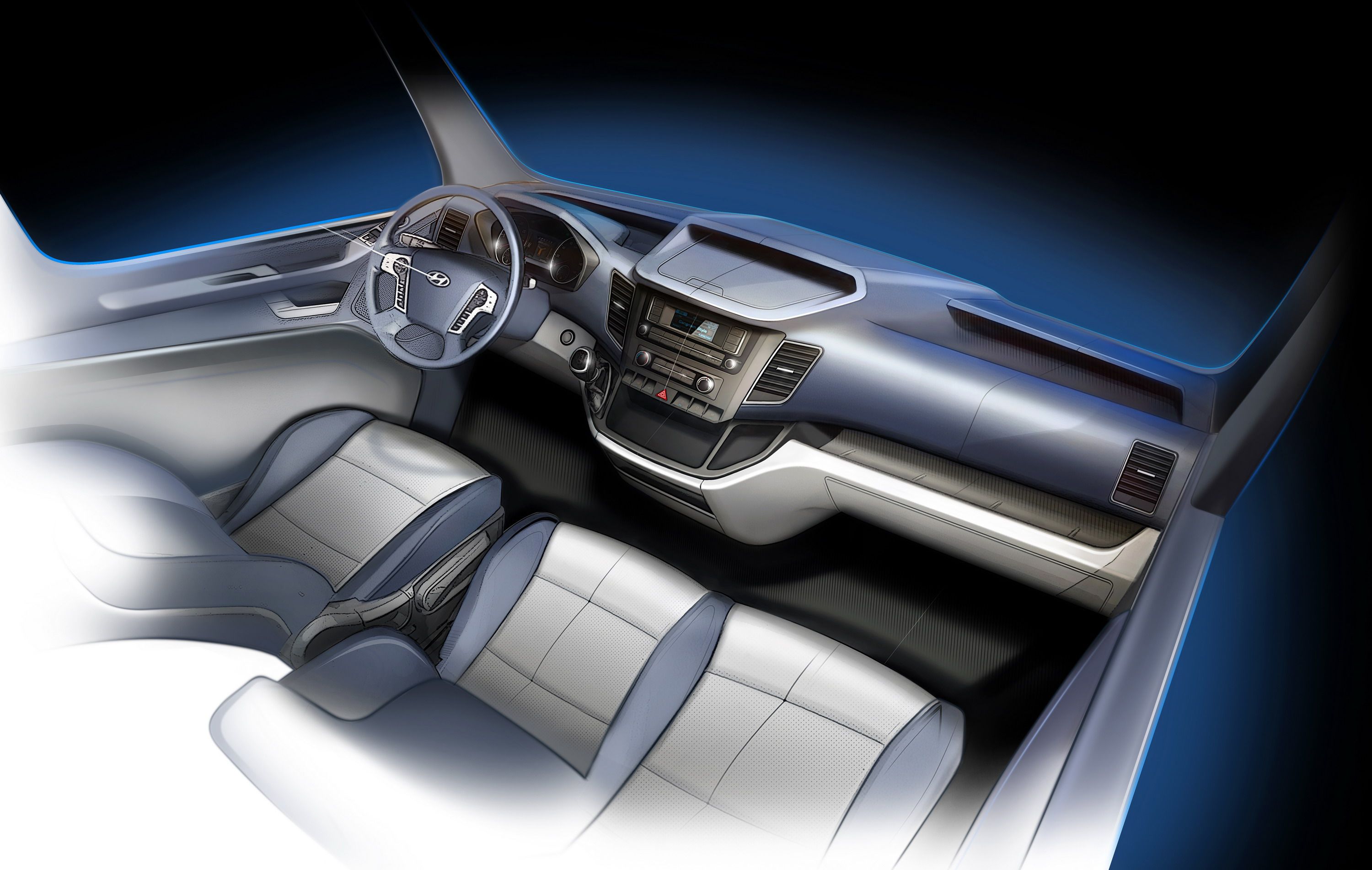Hyundai->ke201 is vying to enter the highly competitive European van market with its all-new H350 van. Sporting a familiar face borrowed from its consumer vehicle lineup, the H350 offers configurations as a cargo van, passenger van, and even a flatbed truck. While the H350 isn’t likely to hit U.S. shores anytime soon, the fact Hyundai is taking on the likes of Mercedes-Benz, Ford, Fiat, and even Nissan is big news.
The Korean automaker started with a clean sheet of paper when designing the H350. High-strength steels make up a majority of the van’s construction and much attention was paid to its powertrain options. Even the level of interior refinement seems above par for the segment. Hyundai has a lot to prove, after all.
Hyundai gives customers the choice between two separate tunes of the same 2.5-liter, turbo-diesel engine, with the more powerful of the two producing 167 horsepower and 311 pound-feet of torque. The turbo-diesel is mated to a six-speed manual transmission that powers the front wheels.
The H350 comes equipped with a host of safety->ke2860 and driver convenience functions as well. A 4.2-inch TFT display keeps the driver informed on vial stats while a high-strength steel passenger compartment ensures occupant safety. A full suite of electronic nannies help keep the top-heavy H350’s shiny side up.
While Hyundai is currently releasing the H350 only in European->ke139 and other world markets, a large success there could see it arriving on U.S. shores within a few years. Holding back the process would be diesel development and passing the U.S. emissions standards.
Click past the jump to read more about the 2015 Hyundai H350.
2015 Hyundai H350
- Make: Array
- Model: 2015 Hyundai H350
- Engine/Motor: inline-4
- Horsepower: 147 @ 3600
- Torque: 275 @ 1350
- [do not use] Vehicle Model: Array
Exterior
The H350 does an excellent job of letting onlookers know what company it belongs to. Its front fascia is unmistakably Hyundai. Projector beam headlights and LED accents give it a decidedly premium look. Besides its aesthetics, Hyundai made the H350’s exterior extremely functional. Integrated steps in the front bumper allow easy access to the large windshield for cleaning and the engine bay for repairs.
Around the side are protective panels that reduce the chance of damage and are replaceable if it occurs. A sliding side door gives easy access to the van’s interior while double barn doors out back allow unhindered access to the cargo area.
Equipped with the optional trailer hitch, the H350 will tow 5,511 pounds.
Exterior Dimensions
|
Style |
5.5m |
6.2m |
|
Overall length |
5515 MM |
6195 MM |
|
Overall width |
2038 MM (excluding door mirrors) |
2038 MM (excluding door mirrors) |
|
Overall height |
2685 MM |
2690 MM |
|
Wheelbase |
3435 MM |
3670 MM |
|
Front overhang |
990 MM |
990 MM |
|
Rear overhang |
1090 MM |
1535 MM |
|
Front tread |
1712 MM |
1712 MM |
|
Rear tread |
1718 MM |
1718 MM |
Interior
Hyundai spent a lot of time working on interior comfort and convenience with the H350. A car-like atmosphere is made complete thanks to a large infotainment screen and the 4.2-inch TFT driver’s information display. A large shelf along the passenger’s side of the dashboard allow for storage in addition to the glove box. A flat floor between the front seats allows for easy passage to the rear of the van or placement of extra storage containers.
NVH levels were addressed with plenty of sound deadening materials, keeping occupant comfort high. Large side mirrors with LED turn signals help the driver navigate traffic. The dash-mounted, six-speed manual transmission gear shift looks to be within easy reach of the driver.
Of course, the H350 wouldn’t be a proper van if it couldn’t haul stuff. The passenger version allows for transportation of 15 people while the cargo version has room for five standard Euro pallets. Thanks to those large rear doors, the pallets fit perfectly in without issue. A total of 14 tie-down points give plenty of options for strapping down loads.
Interior Dimensions
|
Head room |
1414 MM |
|
Leg room |
1071 MM |
|
Shoulder room |
1600 MM |
Cargo Area
|
5.5m |
6.2m |
|
|
Maximum load length |
3100 MM |
3780 MM |
|
Maximum load space width |
1795 MM |
1795 MM |
|
Load space between wheel arches |
1380 MM |
1380 MM |
|
Load to floor |
1955 MM |
1955 MM |
|
Loading height |
695 MM |
700 MM |
|
Load volume (m3) |
10.5 MM |
12,9 MM |
|
Side door entry width |
1279 MM |
1279 MM |
|
Side door entry height |
1937 MM |
1937 MM |
|
Rear door entry width |
1538 MM |
1538 MM |
|
Rear door entry height |
1810 MM |
1810 MM |
Drivetrain
Powering the Hyundai H350 is a 2.5-liter turbo diesel. It features a common-rail fuel system and an electronically controlled turbocharger. Hyundai offers two separate outputs for the diesel. The standard output has the turbo diesel making 147 horsepower and 275 pound-feet of torque. The high-output version makes 167 horses and 311 pound-feet of torque.
The engine comes complete with an automatic start/stop feature that saves fuel while stationary. A dash-mounted gear selection indicator helps the driver make the most out of the six-speed manual transmission, the only available transmission on the H350.
|
2.5-liter CRDI (standard power) |
|
|
Type |
Four-cylinder common rail direct injection turbo diesel |
|
Capacity |
2.5-liter / 2497 cc |
|
Bore x stroke |
91 x 96 mm |
|
Power |
147 HP / 110 Kw at 3600 rpm |
|
Torque |
275 LB-FT / 373 Nm at 1350~2750 rpm |
|
Maximum speed |
97 mph / 156 km/h |
|
2.5-liter CRDI (high power) |
|
|
Type |
Four-cylinder common rail direct injection turbo diesel |
|
Capacity |
2.5-Liter / 2497 cc |
|
Bore x stroke |
91 x 96 mm |
|
Power |
167 HP / 125 kw at 3600 rpm |
|
Torque |
311 LB-FT / 422 Nm at 1500~2750 rpm |
|
Maximum speed |
107 mph / 173 km/h |
Prices
Hyundai has yet to release pricing on the H350, but stay tuned for any future updates.
Competition
Ford Transit
Ford also has a new contender in the fight with its all-new and full-sized Transit van. The van comes in multiple lengths, roof heights, and wheelbases to meet individual customers’ needs. A swanky interior looks like it was borrowed from the Focus, while its powertrain gets the EcoBoost and turbo-diesel treatment.
Three separate engines are available in the Transit, at least in the U.S. market. Those include the naturally aspirated 3.7-liter V-6, the 3.5-liter EcoBoost and the 3.2-liter turbo diesel inline five-cylinder. Outputs range from 200 to 350 horsepower, while torque ranges from 300 pound-feet to an impressive 365. The Transit shifts gears though a six-speed automatic.
Estimated pricing for the Transit starts around the $27,000 mark and likely rises to the near $50,000 level.
Mercedes-Benz Sprinter
The Mercedes Sprinter has long been the go-to van in the European industry. Offering multiple lengths, heights, cargo, and passenger configurations, the Sprinter upholds a long tradition of success.
The Sprinter comes powered by a 2.1-liter I-4 turbo diesel making 161 horsepower and 265 pound-feet of torque. An optional V-6 turbo-diesel engine is available making 186 horsepower and 325 pound-feet of torque.
Pricing for the U.S.-spec Sprinter starts at $35,920 and rises to $43,830 for the 3500 series with the extended wheelbase.
Conclusion
Hyundai’s first stab at the European van market seems to be a solid one. A stout diesel engine with an optional high-output tune, along with tons of cargo space and the option of built-in cabinetry offers the versatility van customers look for. The H350’s passenger version also scores high in comfort in its seating for 15.
While it might not be headed to the States, the waves from Hyundai’s global splash will surely be felt on our shores.








